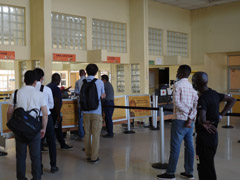Outline of the Project
Project Name
The Project for Capacity Development on Smooth Operation of OSBPs on the North-South Transport Corridor
Country
Zambia, Zimbabwe
Date R/D Signed
August 27, 2020
Term of Cooperation
From December 14, 2020 to March 31, 2025
Implementing Organization
Zambia Revenue Authority (ZRA), and Zimbabwe Revenue Authority (ZIMRA) (*Subject to change in the future)
Background
In May 2019, the African Continental Free Trade Agreement (AfCFTA), which involves 54 African countries (excluding Eritrea), entered into force. The AfCFTA is expected to promote interregional integration toward realization of Agenda 2063, in which the African Union (AU) presented its long-term vision for African development. Trade facilitation is widely recognized as a means of reducing regional business costs, attracting investment and stimulating economic development.
The AU and the African Union Development Agency / New Partnership for Africa's Development (AUDA-NEPAD) have been promoting economic integration in collaboration with regional economic communities (RECs), which are the building blocks of the AfCFTA and which among other things have been promoting OSBPs. As noted, OSBPs enable efficient movement of people and goods by simplifying border control procedures, to be carried out in one country only (the country of entry) rather than carried out in both the exit country and the entry country.
The three focus countries for this project - Zambia, Zimbabwe, and Botswana - are landlocked and consequently their imports and exports require long transport times and high costs. Since the North-South Corridor from Durban, a major port in South Africa, to Lusaka, the capital of Zambia, is regarded as a main corridor in the logistics network of Southern Africa, trade facilitation through operationalization or improvement of OSBPs at borders is expected to provide substantial benefits
The Overall Goal
Enhance trade along the North-South Corridor through facilitation of targeted OSBPs.
Project Purpose
Customs clearance procedures at the targeted OSBPs are improved.
Output
- The operational structure of the OSBP is established and implemented.
- The operational manual for the targeted OSBPs is established through customs capacity development.
- The operational manual for the targeted OSBPs is utilized at other OSBPs in the Southern Africa region.
Project Activities
| 0-1. | Conduct baseline surveys at the targeted borders with relevant organizations in each country. |
| 0-2. | Conduct endline surveys at the targeted borders with relevant organizations in each country. |
| 1-1. | Review the existing legal framework, institutional structure and border management procedures for targeted OSBP. |
| 1-2. | Review other donor's activities in targeted borders and seek collabolation possibility with such agensies and seek relaxed relathionship with immigration and quarantine activities. |
| 1-3. | Based on Activities 1-1 and 1-2, develop an action plan for smooth implementation of targeted OSBPs including related agency's responsibility and schedule. |
| 1-4. | Support to reestablish or activate OSBP operational organization composed of related agencies in Chirundu border after surveying the border situation/ Support to establish OSBP operational committiee composed of related agencies in Kazungula border. |
| 2-1. | Review current guidelines/manuals and trainig contents related with Chirundu border./ Sort tasks related to future operation in Kazungla border based on the actioin plan made in Activity 1-3. |
| 2-2. | Based in Activity 2-1, revise operational guideline and manual for OSBP operation, and edit new materials if necessary. |
| 2-3. | Arrange and conduct third country training to learn from preceding OSBP cases in EAC region. |
| 2-4. | After Activities 2-2 and 2-3, conduct sensitization workshops, and on the job training. |
| 2-5. | Monitor daily OSBPs operation and check if there are any challenges, room for improvement. |
| 2-6. | Analyze the monitoring results, identify challenges and consider the measures for improvement. |
| 2-7. | Hold relevant committee's meeting regularly to share monitoring results and improve the procedures based on Acvitity 2-5. |
| 2-8. | Review the OSBP operation based on Activity 2-7. |
| 2-9. | Revise the documents made in Activity 2-1, if necessary. |
| 3-1. | Draw lessons from the experiences in OSBP operation at the targeted borders to be utilized at other borders. |
| 3-2. | Hold regular meetings with relevant RECs to share the results of Activity 3-1. |
| 3-3. | Cooperate with related RECs for establishing/revising OSBP regional manual and new version of the OSBP Sourcebook. |
*Activities subject to change.
Inputs
[Japanese side]
Dispatch of experts, training in third countries related to OSBP operation (visits to EAC countries, etc.)
Inputs
[Counterpart side]
Assignment of counterparts, provision of relating activities, facilities, and local expenses for implementation.


- About JICA
- News & Features
- Countries & Regions
- Our Work
- Thematic Issues
- Types of Assistance
- Partnerships with Other Development Partners
- Climate Change / Environmental and Social Considerations
- Evaluations
- Compliance and Anti-corruption
- Science and Technology Cooperation on Global Issues
- Research
- JICA Development Studies Program / JICA Chair
- Support for the Acceptance of Foreign HRs / Multicultural and Inclusive Community
- Publications
- Investor Relations
